The Triassic is a geologic period and system which spans 50.6 million years from the end of the Permian Period 251.902 million years ago (Mya), to the beginning of the Jurassic Period 201.36 Mya. The Triassic is the first and shortest period of the Mesozoic Era. Both the start and end of the period are marked by major extinction events. The Triassic Period is subdivided into three epochs: Early Triassic, Middle Triassic and Late Triassic.

The Triassic–Jurassic (Tr-J) extinction event, sometimes called the end-Triassic extinction, marks the boundary between the Triassic and Jurassic periods, 201.3 million years ago, and is one of the major extinction events of the Phanerozoic eon, profoundly affecting life on land and in the oceans. In the seas, the entire class of conodonts and 23–34% of marine genera disappeared. On land, all archosauromorphs other than crocodylomorphs, pterosaurs, and dinosaurs went extinct; some of the groups which died out were previously abundant, such as aetosaurs, phytosaurs, and rauisuchids. Some remaining non-mammalian therapsids and many of the large temnospondyl amphibians had gone extinct prior to the Jurassic as well. However, there is still much uncertainty regarding a connection between the Tr-J boundary and terrestrial vertebrates, due to a paucity of terrestrial fossils from the Rhaetian (latest) stage of the Triassic. What was left fairly untouched were plants, dinosaurs, pterosaurs and mammals; this allowed the dinosaurs and pterosaurs to become the dominant land animals for the next 135 million years.

Therapsida is a major group of eupelycosaurian synapsids that includes mammals, their ancestors and relatives. Many of the traits today seen as unique to mammals had their origin within early therapsids, including limbs that were oriented more underneath the body, as opposed to the sprawling posture of many reptiles and salamanders.
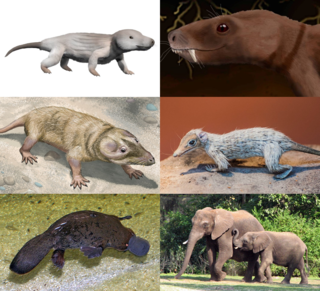
The cynodonts are a clade of eutheriodont therapsids that first appeared in the Late Permian, and extensively diversified after the Permian–Triassic extinction event. Cynodonts had a wide variety of lifestyles, including carnivory and herbivory. Mammals are cynodonts, as are their extinct ancestors and close relatives, having evolved from advanced probainognathian cynodonts during the Late Triassic. All other cynodont lines went extinct, with the last known non-mammalian cynodont group, the Tritylodontidae having its youngest records in the Early Cretaceous.

The Tipulomorpha are an infraorder of Nematocera, containing the crane flies, a very large group, and allied families.

The Bibionomorpha are an infraorder of the suborder Nematocera. One of its constituent families, the Anisopodidae, is the presumed sister taxon to the entire suborder Brachycera. Several of the remaining families in the infraorder are former subfamilies of the Mycetophilidae, which has been recently subdivided. The family Axymyiidae has recently been removed from the Bibionomorpha to its own infraorder Axymyiomorpha.
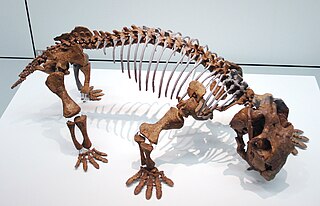
Anomodontia is an extinct group of non-mammalian therapsids from the Permian and Triassic periods. By far the most speciose group are the dicynodonts, a clade of beaked, tusked herbivores. Anomodonts were very diverse during the Middle Permian, including primitive forms like Anomocephalus and Patranomodon and groups like Venyukovioidea and Dromasauria. Dicynodonts became the most successful and abundant of all herbivores in the Late Permian, filling ecological niches ranging from large browsers down to small burrowers. Few dicynodont families survived the Permian–Triassic extinction event, but one lineage (Kannemeyeriiformes) evolved into large, stocky forms that became dominant terrestrial herbivores right until the Late Triassic, when changing conditions caused them to decline, finally going extinct during the Triassic-Jurassic extinction event.
The Late Triassic is the third and final epoch of the Triassic Period in the geologic time scale, spanning the time between 237 Ma and 201.3 Ma. It is preceded by the Middle Triassic Epoch and followed by the Early Jurassic Epoch. The corresponding series of rock beds is known as the Upper Triassic. The Late Triassic is divided into the Carnian, Norian and Rhaetian Ages.
Blikanasaurus is a genus of sauropodomorph dinosaur from the late Triassic of South Africa. The generic name Blikanasaurus is derived from Greek, meaning "lizard from Blikana". The species name cromptoni is taken from the surname of A.W. “Fuzz” Crompton, an American paleontologist who led numerous field expeditions in Elliot Formation outcrop localities in South Africa. Blikanasaurus is only known from partial hindlimb bones that were recovered from the lower Elliot Formation (LEF) in the Eastern Cape.

Therocephalia is an extinct suborder of eutheriodont therapsids from the Permian and Triassic. The therocephalians ("beast-heads") are named after their large skulls, which, along with the structure of their teeth, suggest that they were carnivores. Like other non-mammalian synapsids, therocephalians were once described as "mammal-like reptiles". Therocephalia is the group most closely related to the cynodonts, which gave rise to the mammals. This relationship takes evidence in a variety of skeletal features.
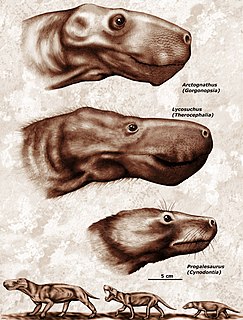
The theriodonts are a major group of therapsids which appeared during the Middle Permian and which includes the gorgonopsians and the eutheriodonts, itself including the therocephalians and the cynodonts.

Dinosauromorpha is a clade of avemetatarsalian archosaurs that includes the Dinosauria (dinosaurs) and some of their close relatives. It was originally defined to include dinosauriforms and lagerpetids, with later formulations specifically excluding pterosaurs from the group. Birds are the only dinosauromorphs which survive to the present day.
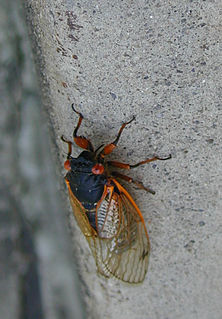
Cicadomorpha is an infraorder of the insect order Hemiptera which contains the cicadas, leafhoppers, treehoppers, and spittlebugs. There are approximately 35,000 described species worldwide. Distributed worldwide, all members of this group are plant-feeders, and many produce either audible sounds or substrate vibrations as a form of communication. The earliest fossils of cicadomorphs first appear during the Late Permian.

Chigutisauridae is an extinct family of large temnospondyl amphibians. The only genera recognized as belonging to Chigutisauridae at the current time are all from Gondwana. Chigutisaurids first appeared during the Early Triassic in Australia. During the Late Triassic they became widely distributed in Gondwana, with fossils found in South Africa, India and South America. Koolasuchus from the Early Cretaceous of Australia represents the youngest known temnospondyl.

Lapillopsidae is a family of Temnospondyli.

Trematosauridae are a family of large marine temnospondyl amphibians with many members. They first appeared during the Induan age of the Early Triassic, and existed until around the Carnian stage of the Late Triassic, although by then they were very rare. By the Middle Triassic they had become widespread throughout Laurasia and Gondwana with fossils being found in Europe, Asia, Madagascar, and Australia.
Almasaurus is an extinct genus of trematosaurian temnospondyl within the family Latiscopidae. It is known from several skulls and some postcranial material found from the Argana Formation in Morocco, which dates back to the Late Triassic.

Thoosuchus is an extinct genus of basal trematosauroid trematosaurian temnospondyl. Fossils have been found from Russia and date back to the Early Triassic. It is the type genus of the family Thoosuchidae, formerly called the subfamily Thoosuchinae and placed within Benthosuchidae. The benthosuchids were originally composed of the majority of basal trematosaurian forms regarded as the ancestors of the trematosaurids. Although the genus was first named in 1940, material from one species, E. yakovlevi, was originally tentatively referred to Trematosuchus in 1926.
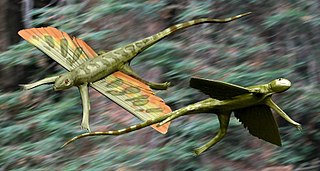
Kuehneosauridae is an extinct family of small, lizard-like gliding diapsids known from the Triassic period of Europe and North America. They are distinguished from other diapsids by their 'wings' formed by elongated ribs. These allowed the animal to glide and parachute similar to living gliding lizards. They were most likely insectivorous, judging from their pin-like teeth. They are often, but not always, placed in the group Lepidosauromorpha, though other studies have recovered them in other positions within Sauria, including Archosauromorpha. The oldest and most primitive known member is Pamelina from the Early Triassic of Poland, which already has vertebrae with characteristics consistent with gliding or parachuting. Icarosaurus is known from a single specimen from the Carnian-aged Lockatong Formation of New Jersey. The Late Triassic kuehneosaurids from England, Kuehneosaurus and Kuehneosuchus, are very similar and can be distinguished from one another primarily on the length of their "wing" ribs, relatively short and massive in Kuehneosaurus but longer and more gracile in Kuehneosuchus. Kuehneosaurus was likely only capable of parachuting, while Kuehneosuchus could probably glide. Rhabdopelix may have been a kuehneosaurid; however, the fossils were lost, and the characteristics described are not entirely consistent with the other family members.
Latiscopus disjunctus is a small Late Triassic temnospondyl collected in 1940 by a Works Projects Administration crew working near Otis Chalk, Texas that was described by John Wilson in 1948.















